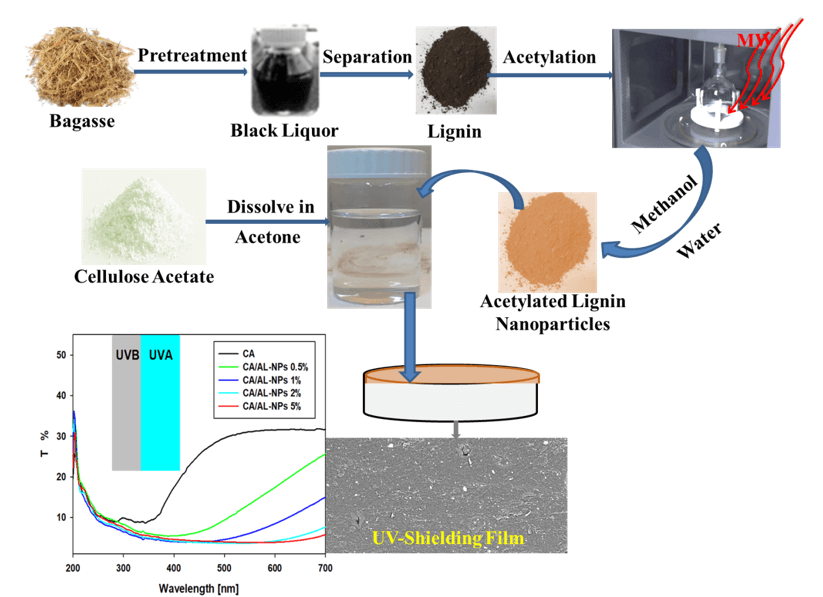 Open Access
Open Access
ARTICLE
Microwave-Assisted Acetylated Lignin Loaded into Cellulose Acetate for Efficient UV-Shielding Films
1 Photochemistry Department, National Research Centre, Giza, 12622, Egypt
2 Cellulose and Paper Department, National Research Centre, Giza, 12622, Egypt
* Corresponding Author: Samir Kamel. Email:
Journal of Renewable Materials 2025, 13(2), 401-412. https://doi.org/10.32604/jrm.2024.057419
Received 16 August 2024; Accepted 01 November 2024; Issue published 20 February 2025
Abstract
Developing favorable bio-based polymers that replace petroleum-based plastics is an essential environmental demand. Lignin is a by-product of the chemical pulping industry. It is a natural UV protection ingredient in broad-spectrum (UVA and UVB) sunscreens. It could be partially and selectively acetylated in a simple, fast, and more reliable process. In this work, a composite film was prepared with UV-resistant properties through a casting method. Bio-based cellulose acetate (CA) was employed as a major matrix while nano-acetylated kraft lignin (AL-NPs) was used as filler during synthesizing UV-shielding films loaded with various amounts (1–5 wt.%) of AL-NPs. Kraft lignin was acetylated through a simple and fast microwave-assisted process using acetic acid as a solvent and acetylating agent. The physicochemical and morphological characteristics of the prepared films were evaluated using different methods, including scanning electron microscopy (SEM), Fourier Transform Infrared Spectroscopy (FTIR), X-ray diffraction analysis (XRD), mechanical testing and contact angle measurement. The UV-Vis spectroscopy optical investigation of the prepared films revealed that AL-NPs in the CA matrix showed strong UV absorption. This feature demonstrated the effectiveness of our research in developing UV-resistant bio-based polymer films. Hence, the prepared films can be considered as successful candidates to be applied in packaging applications.Graphic Abstract

Keywords
Cite This Article
 Copyright © 2025 The Author(s). Published by Tech Science Press.
Copyright © 2025 The Author(s). Published by Tech Science Press.This work is licensed under a Creative Commons Attribution 4.0 International License , which permits unrestricted use, distribution, and reproduction in any medium, provided the original work is properly cited.


 Submit a Paper
Submit a Paper Propose a Special lssue
Propose a Special lssue View Full Text
View Full Text Download PDF
Download PDF Downloads
Downloads
 Citation Tools
Citation Tools